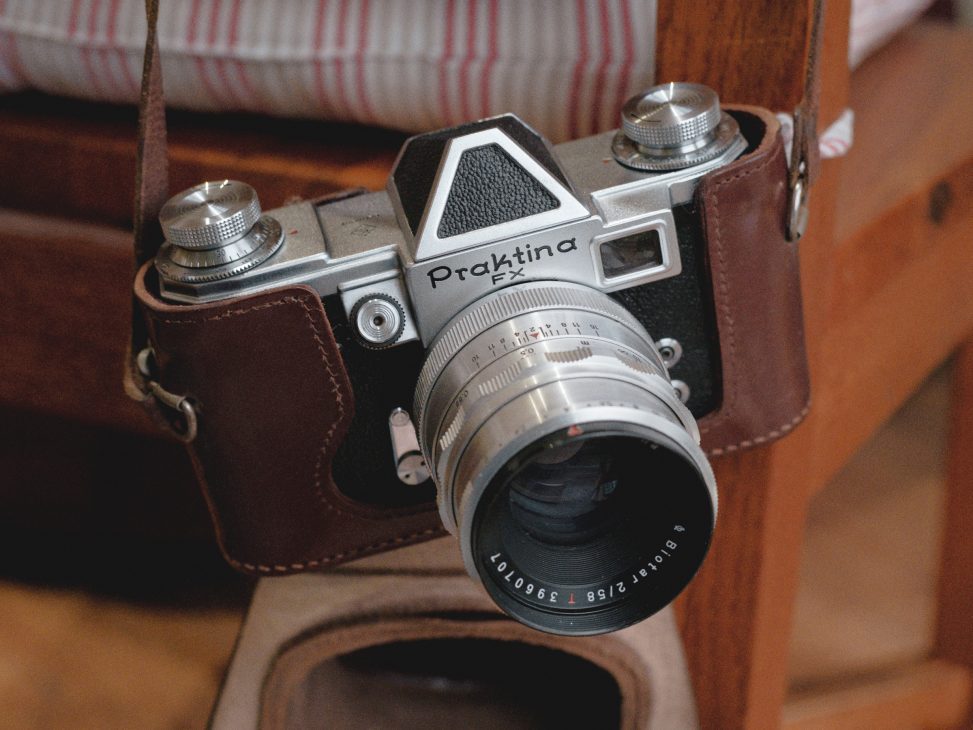Kamera-Werkstätten’s great leap forward in SLR photography.

The year is 1953. East Germany leads the way in optical excellence and camera innovation. In a few short years, Japanese camera manufacturers will come to reign supreme, but in the fifties, Dresden was the camera making centre of the world. The city had a long association with photography, dating back to the later years of the nineteenth century. Kamera-Werkstäten (KW) was nationalised in 1946, and had by then a significant heritage in photography. In 1939, KW introduced the Praktiflex, their first landmark camera. The Praktiflex was the world’s first small-format SLR camera with a returnable mirror and a screw mount for interchangeable lenses. 15 years later, they made another remarkable camera.
Why is the Praktina FX a Landmark Camera?
1: The world’s most advanced SLR and the first professional 35mm camera system with a range of accessories.
2: The first SLR camera equipped to take a motor drive.
3: The first SLR camera to have an automatic diaphragm mechanism in the camera body.
4: The first SLR camera to have a single-axis non-rotating shutter speed dial.
Okay, it may look quaint and old hat now, but this robust camera was the future in the early fifties. An SLR with an interchangeable viewfinder, focusing screen and lenses, and sporting 1/1000th second top shutter speed, and even a motor wind option, simply did not exist. You could even have a magazine back so you could snap, snap and snap.
The User Experience
The Look
When I first acquired the Praktina FX, I had no other camera like it in my collection. It looked alien and yet familiar at the same time, with a contemporary looking Carl Zeiss Jena Biotar lens with the famous red ‘T’ attached to an elegant, art decoesque camera body. It came in its original brown leather case with strap. Cosmetically, camera and case are in excellent condition. There’s a small amount of fungus on the front lens element and the viewfinder is showing its age.

The Feel
It feels premium. The covering is real leather, not synthetic leatherette, and it looks as good as the day it was put on. The leather covering on the removal prism is a nice design touch. Even the camera base has a leather covering. None of this has degraded or peeled in any way, unlike the leatherette on some later SLRs was prone to do. The twin dials on the extreme left and right of the top of the camera are wonderfully engraved. The shutter speed dial is smooth and stepless as is the ISO dial on the opposite side. The knob film wind is slower to operate than the later lever would be, but not a hindrance to the rush-free photography I practised with this camera. The shutter release is on the front of the camera body, rather than the top. This would be a characteristic of VEB cameras for years to come.
In Use
Much better than expected. I am slightly embarrassed to say I didn’t have high expectations. I had heard it wasn’t that successful and was perhaps expecting an early 50’s SLR to not cut it. What do I know? Well, it gives a more modern experience than, well, some more modern cameras.

The Fresnel-free, split image focusing screen is a cinch to use. The viewfinder is big enough and bright enough when using full-aperture focusing, which is achieved by moving a catch on the bottom of the lens clockwise. The lens has a semi-automatic diaphragm; aperture is selected by pulling the aperture ring towards you and then twisting it to your desired aperture. The fast Biotar 58mm f/2 goes to an f/16 aperture. All full stops are engraved on the lens, with half stops marked with a simple red dot.

After pressing the shutter release, the lens stops down to the set aperture but the mirror does not return, so the viewfinder goes dark. Film advance is by knob wind, which also returns the mirror to its lowered position, making the viewfinder usable again. I enjoyed using this camera. Where I struggled was setting the shutter speed. It’s not a clear dial by later standards. Small black engraved numbers on chrome do not stand out well. The only other slightly awkward feature is getting used to the breech lock style lens mount.

I exposed a roll of film on a bright, contrasty day while wandering around the Hartlepool Waterfront Festival. I used Kentmere 400, which was developed in Rodinal. Each frame has a dark area in the same place. I’m not sure of the cause, but I have managed to crop most of this area out in the photographs displayed here.





Further Reading:
Mike Eckman
The Praktina System
Early Photography
Praktica Collector


Colin
Chris, an enjoyable read, you don’t just write about your cameras, you dance and sing them.
Sounds as though you have found a very good condition example of this particular camera.
Chris Pattison
Thanks for your kind comments Colin.
peggy l Hubbard
I have a practina fx also with a long lens 24x36mm. I would like to sell if you know anyone interested. I don’ know the value of this camera with both lenses and the original booklet.
Christopher Pattison
Hi Peggy, I don’t know of anyone interested. As someone said recently, any item is worth what people are prepared to pay. At the moment I am finding that vintage cameras are fetching less money, although a quality item like a Praktina should still do okay.
I would advise looking on eBay and vintage camera shops to get an idea what your Praktina might fetch. Condition can make a big difference to a buyer’s willingness to part with cash.
marcus scholz
Hi Peggy, I may be interested. Can you send me an image to marcus_m_scholz@hotmail.com thanks!